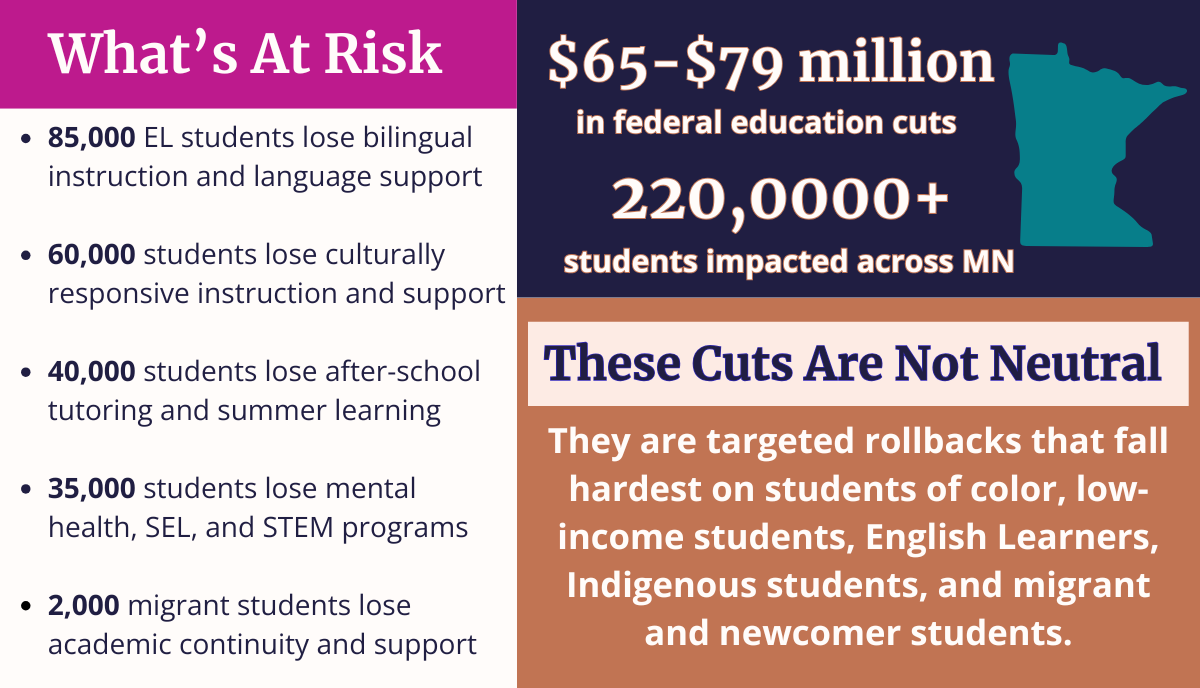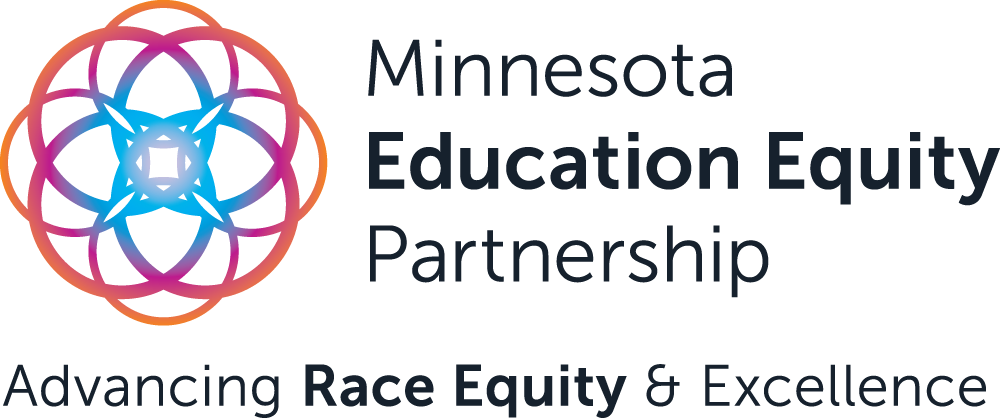
How the Federal Education Cuts Undermine Civil Rights and Student Success—And What You Can Do to Push Back and Push Forward
By Molly Priesmeyer, MnEEP Director of Communications And Hon. Carlos Mariani Rosa, MnEEP Executive Director In Minneapolis, where the district is already grappling with a historic budget crisis, $4.5 million sits out of reach. In St. Paul, $7.2 million is missing from a budget already stretched thin. These are not neutral budget decisions. This freeze is a deliberate and racialized disinvestment in our collective future. And it falls hardest on a rapidly growing student population who already face the steepest barriers to a just and meaningful education. At stake right now are crucial, evidence-based federal Title programs—Title I, Title III, Title II-A, Title IV, and Title I-C—cornerstone policies enacted in 1965 as part of the War on Poverty. These programs were designed to support the success of tens of millions of students across the country impacted by racism, poverty, language discrimination, and displacement. This decades-old investment in student success isn’t extra. It’s foundational. Without it, the very protections that make equitable, inclusive public education possible are completely gutted, leaving states, communities, and schools without the resources they need to ensure every student has an equitable opportunity to thrive. The impact on Minnesota, which already ranks among the worst in the nation for racial disparities in education outcomes, will be profound. These cuts threaten not only hard-won progress across the state, but also risk deepening the educational, economic, and social inequities our state has yet to resolve. While White and wealthier districts will remain largely untouched by these cuts, districts serving low-income students, multilingual learners, Indigenous students, migrant families, and communities of color will suffer the impact immediately and acutely. These districts are now being forced to make impossible choices: cutting staff, eliminating student services, and scaling back successful programs essential to student learning, stability, and wellbeing. For K12 educators, leaders, and staff, this is more than a budget issue. These cuts violate civil rights laws they are required to uphold and undermine Minnesota’s constitutional duty to provide a uniform and equitable education to all learners. How to Use This Resource This guide is designed to name exactly what is happening and why it matters. It aims to shift harmful narratives and re-centers human dignity and educational rights of every student by offering: This is not just about documenting cuts. It’s about reaffirming what Minnesota students deserve and what the law requires. Many of the federal programs now frozen were created to confront deep, systemic discrimination in education. Title III (English Learners), Title I-C (migrant education), and Title II-A (diverse and inclusive teacher development) are not optional add-ons. They are civil rights obligations—hard-won protections that ensure race, gender, language, and immigration status are not barriers to education access and opportunities. Freezing these funds means: The Minnesota Constitution (Art. XIII, Sec. 1) requires the state to provide a “general and uniform system of public schools.” That means every child must have access to a full, adequate, and equitable education, regardless of race, language, income, immigration status, or ZIP code. Minnesota law reinforces this duty in statutes: Targeted rollbacks threaten students’ rights, learning, and futures. ~84,050 students impacted From 2018 to 2022, Minnesota’s EL student population grew from 73,128 (8.5%) in 2018 to 77,473 (8.9%), making it one of the fastest-growing student groups in the state. What Students Lose Equity Impact Why This Matters for Minnesota Research shows that when districts invest in robust EL services such bilingual instruction, family liaisons, and wraparound supports, EL students achieve higher literacy rates, stay on track to graduate, and are more likely to enroll in college. Districts that prioritize these supports also see stronger long-term outcomes, especially when paired with culturally responsive engagement. Without Title III, schools will be forced to scale back or eliminate these critical services, resulting in widening disparities and weakening the state’s ability to meet its legal and moral obligations to educational equity and state economic goals. ~60,000 students impacted Minnesota classrooms are increasingly diverse. Nearly 36% of school-age children are students of color, and in districts like St. Paul, learners speak more than 115 languages. There, 78% of students identify as students of color, and 28% are English Learners (ELs). To support their academic and social success, Minnesota law (Minn. Stat. § 122A.40) requires culturally responsive teaching professional development as part of teacher licensure and evaluation. Title II-A funding makes this possible by supporting professional development that equips educators to engage students’ diverse cultural, racial, and linguistic identities, interrupt bias, and create inclusive, affirming classrooms. What Students Lose Equity Impact Why This Matters for Minnesota Numerous studies show that sustained, equity-centered professional development improves student achievement in both math and reading, particularly when teachers are trained in culturally responsive practices. ~1,500–2,000 students impacted Minnesota supports several thousand migrant students and families, often from seasonal agricultural backgrounds. These learners depend on Title I‑C to remain connected to consistent education across moves. What Students Lose Equity Impact Why This Matters for Minnesota Minnesota’s Migrant Education Program has helped over 90% of mobile students in grades 7–12 stay on track to graduate or advance to the next grade. Title I-C provides the stability these students need to stay connected to school, even as their families move for work. When schools can’t meet the legal and learning needs of mobile students, families are cut off from opportunity, civil rights are eroded, and rural communities lose connection to the very students who help sustain them. ~40,000 students impacted After-school hours are a critical window for students to receive support, build confidence, and connect with their communities. Minnesota’s 21st Century Community Learning Centers (CCLCs) have served as a backbone of enrichment in high-need schools, especially for students of color and those from low-income households. In 2017–2018, 93% of youth in Minnesota’s 21st CCLC programs were students of color, and 89% were eligible for free or reduced-price lunch. What Students Lose Equity Impact Why This Matters for Minnesota These programs extend opportunity into evenings, summers, and weekends. For many students, they are lifelines, providing safe, affirming spaces to learn, connect, and grow. Cutting them shrinks the learning day, disrupts school-community ties, and undermines one of Minnesota’s strongest levers for whole-child equity. Research shows Minnesota CCLCs are critical for student success: During the 2022-2023 school year in Minnesota, 67% of participants improved school-day attendance, 48% raised their GPA, and 86% showed stronger classroom engagement. ~35,000 students impacted Title IV-A supports whole-child learning in Minnesota, and its impact is especially significant for students of color. More than 80% of students in Title I schools identify as students of color. Without these funds, the state strips away critical supports—from mental health services to enriched learning environments—that are essential for the very communities Title IV-A is meant to serve. What Students Lose Equity Impact Why This Matters for Minnesota Without Title IV-A, schools lose the capacity to support students beyond academics. These cuts erode the foundation of whole-child learning and leave students in high-need schools without critical supports that foster growth and success. National research shows that social-emotional learning (SEL) programs can improve academic performance by an average of 11 percentile points, reduce emotional distress, and strengthen classroom behavior and resilience. Moreover, whole-child initiatives that include SEL, mental health, and arts programming lead to stronger school engagement, fewer disciplinary actions, and better long-term academic outcomes, especially in schools serving historically marginalized students. Whether you’re a parent, educator, policymaker, or advocate, here are tangible ways to push back against harmful disinvestment, and push forward toward a racially just education system that fosters inclusion and belonging for every learner. For Parents & Families For Educators For School & District Leaders For Policymakers & Advocates These cuts are not just harmful policy failures. They are a test of whether Minnesota will uphold the rights of students who have too often been left behind. Every student’s success is tied to our shared future. Ensuring that future means refusing to normalize disinvestment, and recommitting to the legal and moral obligations at the heart of public education and education equity. Additional Tools & Resources Sign up for MnEEP Advocacy Tools and Action Alerts MDE – English Learner Task Force Report (2025) MDE – Overview of Federal Education Funds (2025) Afterschool Alliance – Federal Freeze Response (July 2025)
Across Minnesota, an estimated $65 to $79 million in federal education funding is frozen, leaving critical education programs in limbo and more than 220,000 students without essential education supports.
What’s Really Being Cut: Civil Rights, Opportunity, and Minnesota’s Promise
This is Also a Violation of Minnesota Laws
What They’re Cutting — and Who Pays the Price
1. They’re Cutting Language Access
Title III Freezes Undermine EL Equity and Civil Rights
Funds withheld: $11.08 million (FY24/25)
Title III supports Minnesota’s 84,000 English Learner (EL) students—roughly 1 in 10 K–12 learners—by funding bilingual educators, newcomer programs, language acquisition materials, translation and interpretation services, and family engagement.
2. They’re Dismantling Culturally Responsive Education
Title II-A Cuts Gut Training for Equity, Belonging, and Legal Compliance
Funds withheld: $26.59 million (FY24/25)
Culturally validating instruction not only supports academic success, it also strengthens student engagement, belonging, and motivation, especially for students of color.
Without Title II‑A funding, Minnesota risks turning a legal mandate into an unfunded requirement. The result will be teachers less prepared to meet students where they are, and classrooms that fail to reflect and affirm the racial, cultural, and linguistic identities of the students they serve.3. They’re Denying Migrant Students Their Rights
Title I-C Freezes Disrupt Education and Support for Mobile Learners
Funds withheld: $919,671 (FY24/25)
4. They’re Undoing Community Learning
21st CCLC Cuts Strip After-School Enrichment and Family Connection
Funds withheld: ~$13.8 million
5. They’re Erasing Whole-Child Supports
Title IV-A Cuts Eliminate SEL, Mental Health, and Identity-Affirming Learning
Funds withheld: $13.8 million (FY24/25)
What You Can Do: Push Back / Push Forward
This Is a Moment of Public Responsibility
https://www.mneep.org/become-a-member/
https://www.lrl.mn.gov/docs/2025/mandated/250663.pdf
https://assets.senate.mn/committees/2025-2026/3119_Committee_on_Education_Finance/20250104_MDE-Overview-of-Federal-Education-Funds.pdf
https://www.afterschoolalliance.org/afterschoolsnack/Release-the-funds-Responding-to-withholding-of-21st-CCLC-funds_07-07-2025.cfm
